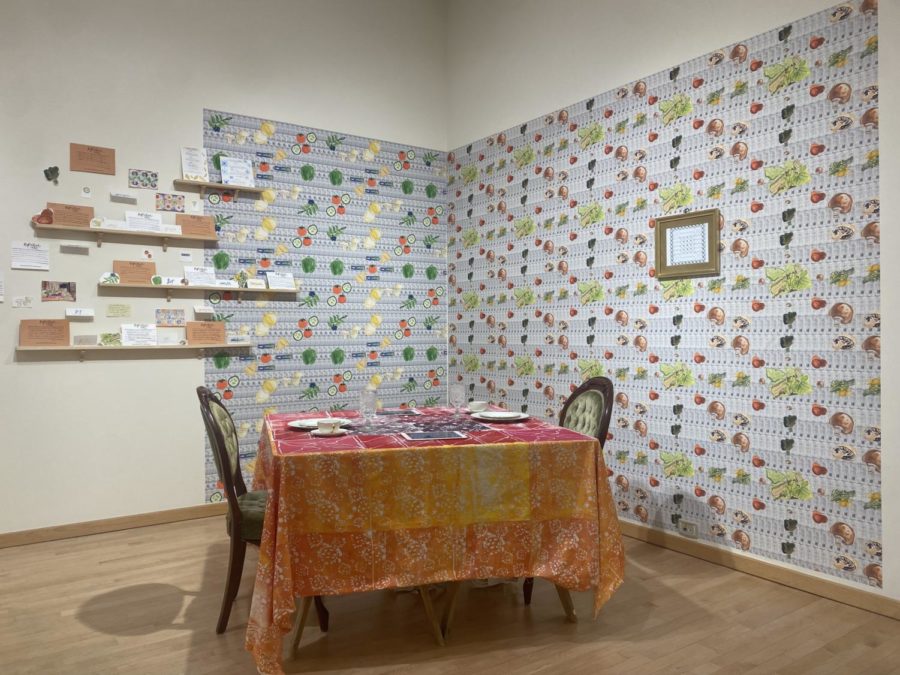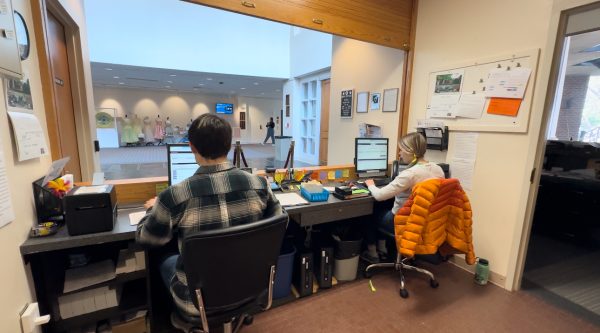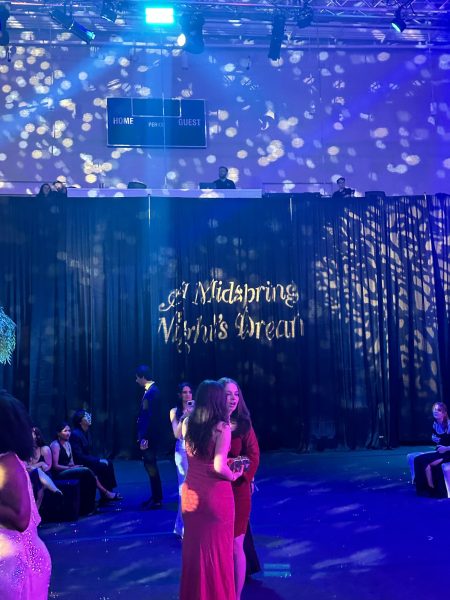Seniors reflect on art thesis exhibition: “Memory & Motion”
The 2022 studio art majors’ final show will remain in Staniar Gallery through April 9
Dibble’s thesis is based on dinner parties and includes a video element. Photo by Jess Kishbaugh, ’24.
April 12, 2022
On March 28, student artists presented their thesis projects and attended a reception for the opening of “Memory & Motion,” displayed in Staniar Gallery through April 9.
The exhibition showcases work from five seniors: Mary Beth Pittman, Ashely Shugart, Madelyn Sheridan, Ruth Dibble and Adam Harter.
For most students, the annual exhibition is their introduction to the process of preparing work for a gallery.
Harter created work inspired by geometry and natural phenomena as in previous classes, but he said the artistic liberty pushed his practice further.
“The thesis was a new experience because it was the first time I didn’t have a prompt from a professor for a project,” Harter said. “It was something I had full creative control on the direction I took it.”
Harter’s project, “Wave Form,” investigates the movement of waves with both 2-D and 3-D media. Using relief prints on newsprint and intricate basswood sculptures, Harter highlights the three main stages of a wave’s life.
“In the three stages I highlight, the radial wave ring pushes out to the edges, forming a new hill in the center. At some point, the dead center is the highest, and at the other, it is the lowest,” Harter wrote in his artist statement.
His 3-D sculptures play with scale and perspective, and Harter said their construction deepened his understanding of the subject.
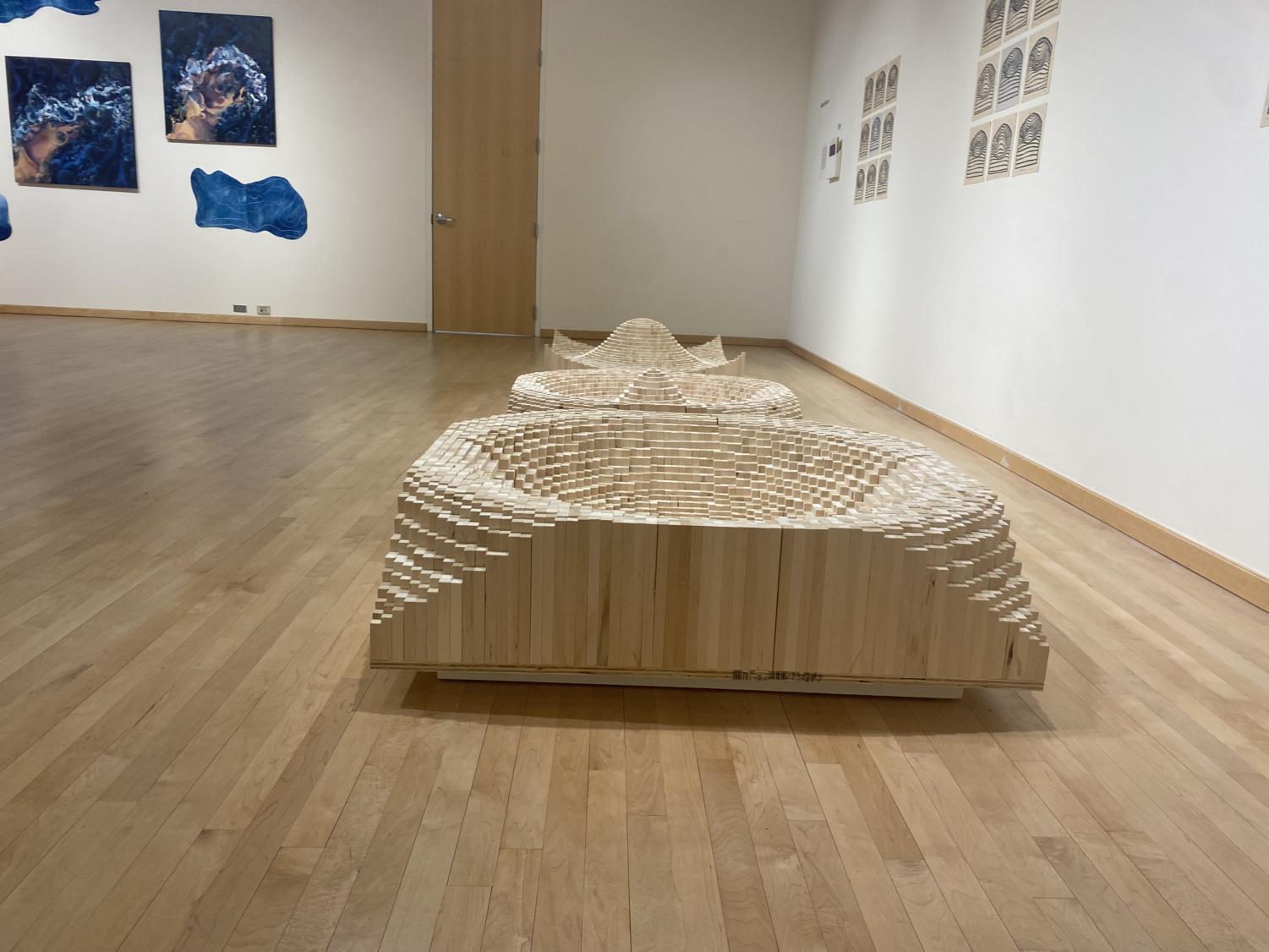
“One of the most important parts of the work is the connection I have developed through the labor of creating it. Each object has 3,721 pieces, 11,163 pieces in total,” he wrote. “The hours and effort are what gives the work extra meaning to me.”
Sheridan also considered waves, or more specifically, the ocean, for her final project. In the artist statement for “Immersion,” Sheridan writes of her personal connection to the sea, which inspired her paintings and cyanotypes.
“The ocean has always been a part of me,” she wrote. “Its cleansing sensation is so deeply engraved in my memory I can feel it on my skin while hundreds of miles away from my home. The sting of the freezing water, the pressure as I dive deeper and deeper, and the feeling of being absolutely engulfed while floating all work together to create a spiritual phenomenon between myself and the ocean.”
Sheridan created two large-scale, abstract oil paint self-portraits to demonstrate this connection. The paintings are based on pictures of the artist’s limbs immersed in the Atlantic Ocean, made abstract by the distortion of their form through the water.
“As various parts of my body are submerged, refracted light, distortions, and bubbles create a sensation of spiritual cleansing, while the large-scale allows viewers to be engulfed by the water,” Sheridan writes.
Making work for a gallery challenged Sheridan to pare down her pieces.
“Gallery preparation was in the back of my head through my entire creative process. I have always loved to work large scale, so I knew that many of my pieces would not make it into the gallery,” she said. “I ultimately learned that even though some works did not make it into the gallery, they were all equally as important in the creative process helping me get to the final product.”
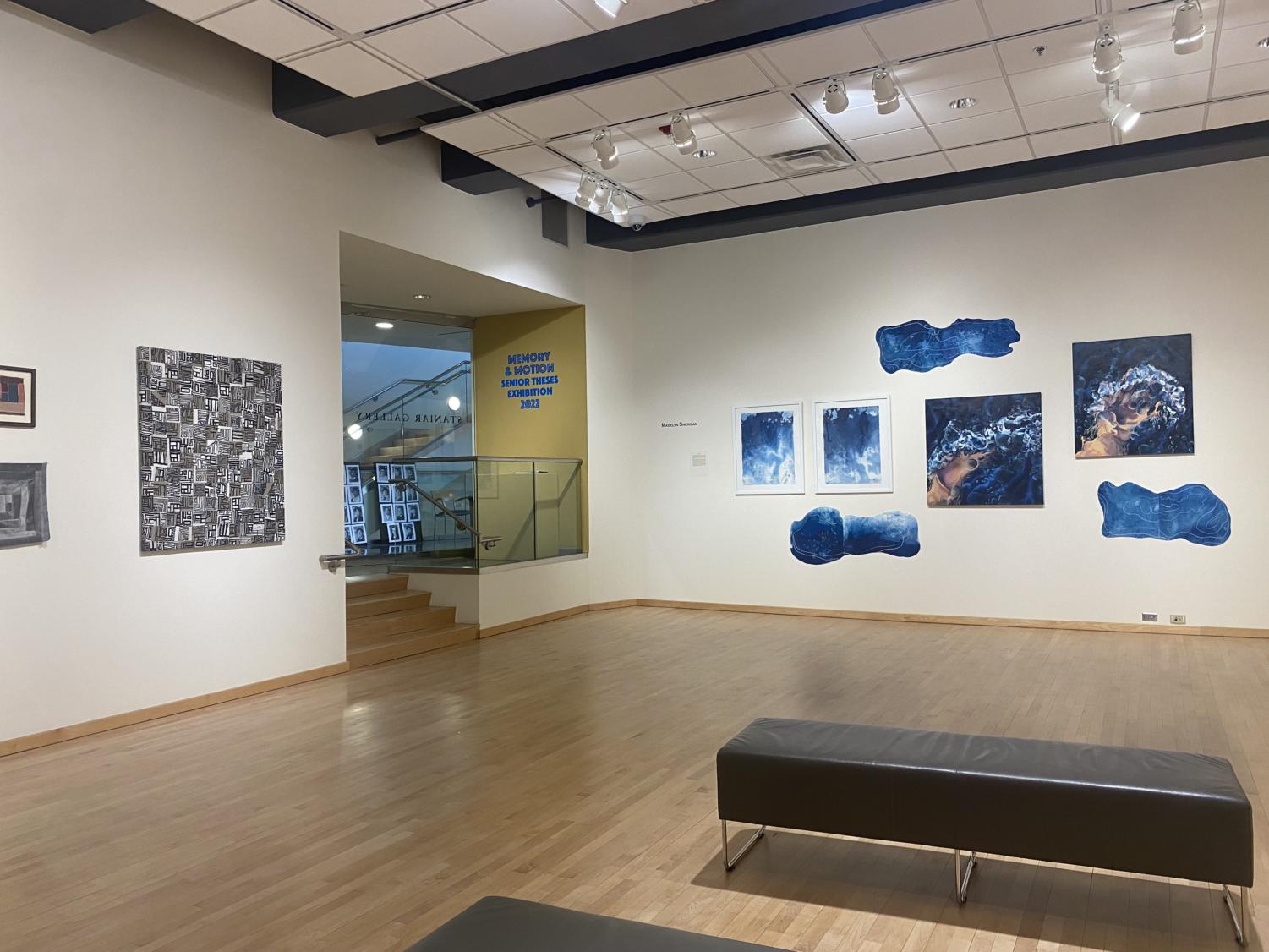
Shugart’s project, “Undoing,” investigates movement through installation and video work inspired by dance, which Shugart calls fundamental to her identity.
In her artist statement, Shugart describes her research into movement patterns and the paths they create in the world.
“In this research, I have narrowed my focus of movement to unraveling — finding how things unwind and detangle,” she said.
Shugart details the translation of movement from one media to another and the importance of process.
“In my recent work this has begun with me creating a stop motion film,” Shugart writes. “I often start here because I enjoy beginning my work with something movement based. I then move to find aspects of the films I make that I want to expand on.”
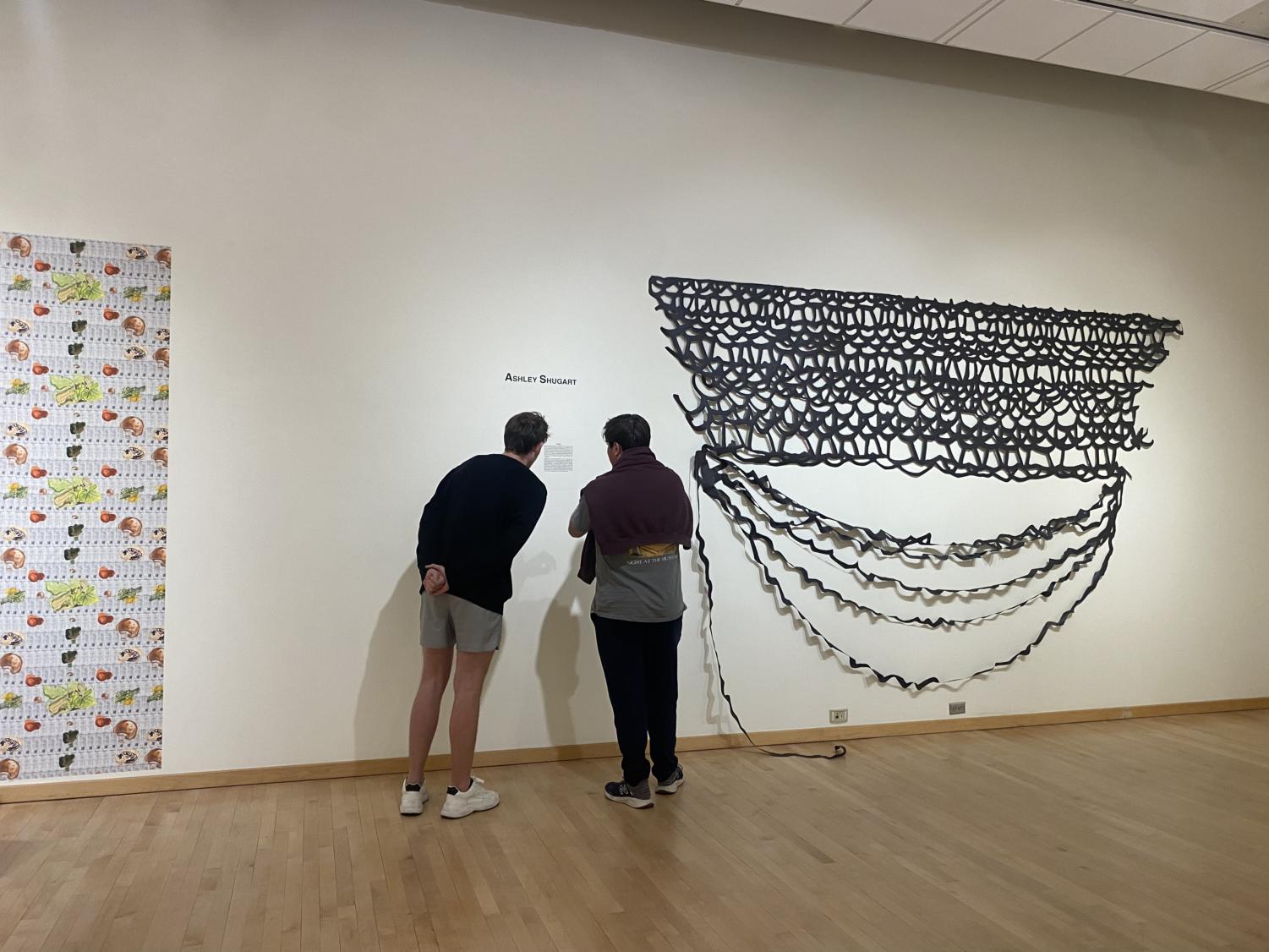
Dibble’s work also contains a video element, which captures the integral interactive component of her project. “Around the Table” is based on dinner parties Dibble hosted with relative strangers from the Washington and Lee student community and recorded using film, patterns based on saved grocery receipts and a collection of guest reflection cards, all displayed in Staniar gallery.
She describes the themes of her project in her artist statement.
“My work is a representation of my love for patterns, building community, and creating shared experiences,” she wrote. “Using linoleum block printing, film, and pattern design, I specifically explore how a shared meal can further guests’ appreciation of being able to gather.”
Part of Dibble’s inspiration came from the forced social isolation of COVID-19, and she incorporated “Covid imagery” into the patterned tablecloth she designed.
“I chose warm yellows, oranges, red, and a cool, deep purple to emulate the warmth felt around a table with those you love. The symbols that once kept family and friends apart now unite strangers and friends for a shared meal,” she said.
For Dibble, the coursework leading up to the thesis changed her approach and led her to installation work.
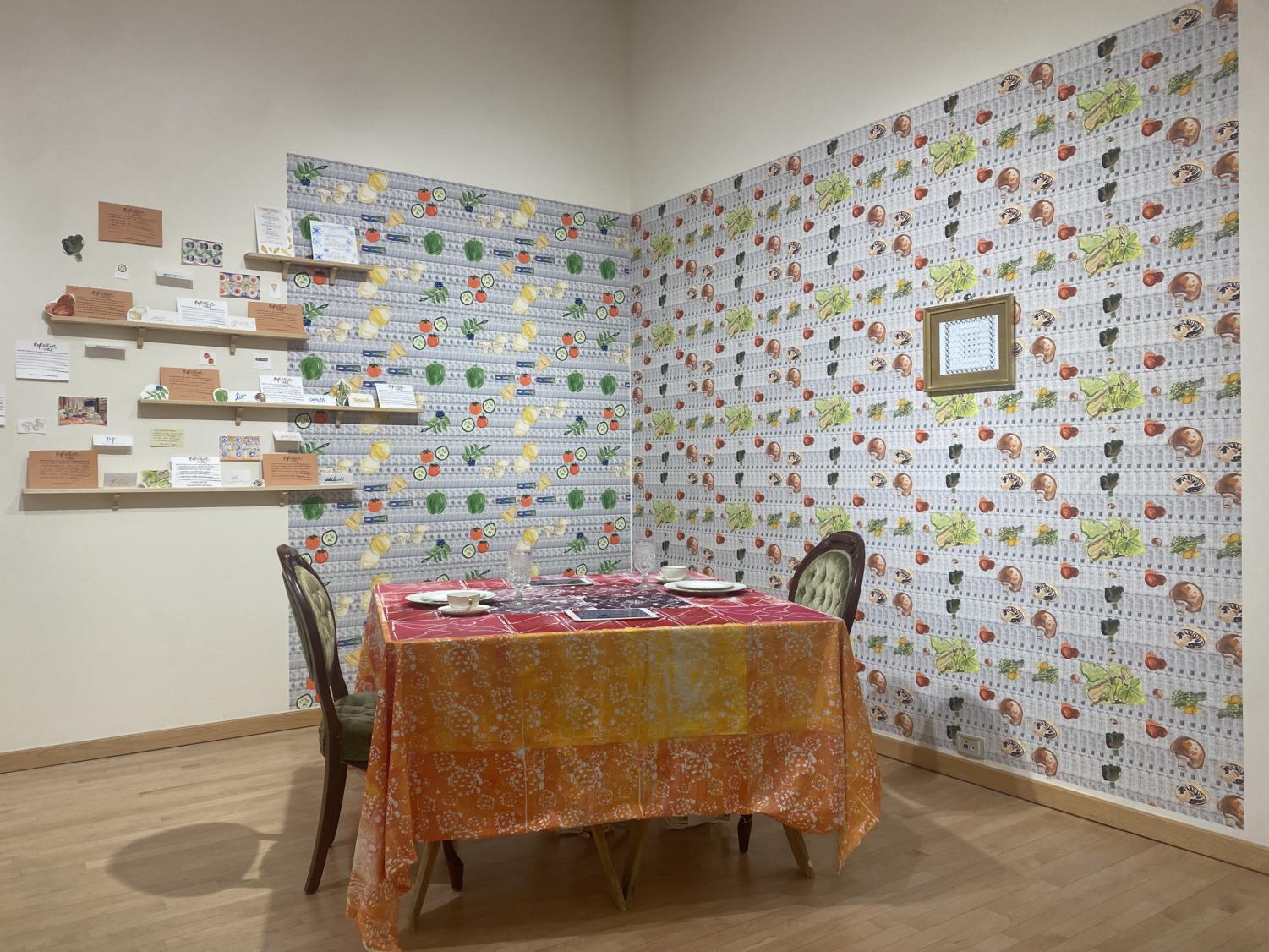
“I took a much more mixed media approach for the work for my thesis. I started to think about how I could create an experience, specifically something more interactive for Staniar Gallery,” she said.
“At W&L, as a sophomore, I always thought I’d do something with oils or acrylics for my final body of work,” Dibble explained. “However, after taking the prerequisite course for the thesis, Junior Seminar with Professor Beavers, I learned more about contemporary artists. These artists like Sarah Sze and Yinka Shonibare continue to push the boundaries of art. After looking at nearly 40 artists, I realized the work I found most compelling involved other people and installation.”
Textile pattern and family feature heavily in Pittman’s project “Log Cabin Deconstruction: exploring memory and form through the domestic sphere.”
Pittman describes how her tenth-grade teacher taught her how to quilt, and how now, in the midst of life changes, she relied on the familiarity of the skill to make sense of the world.
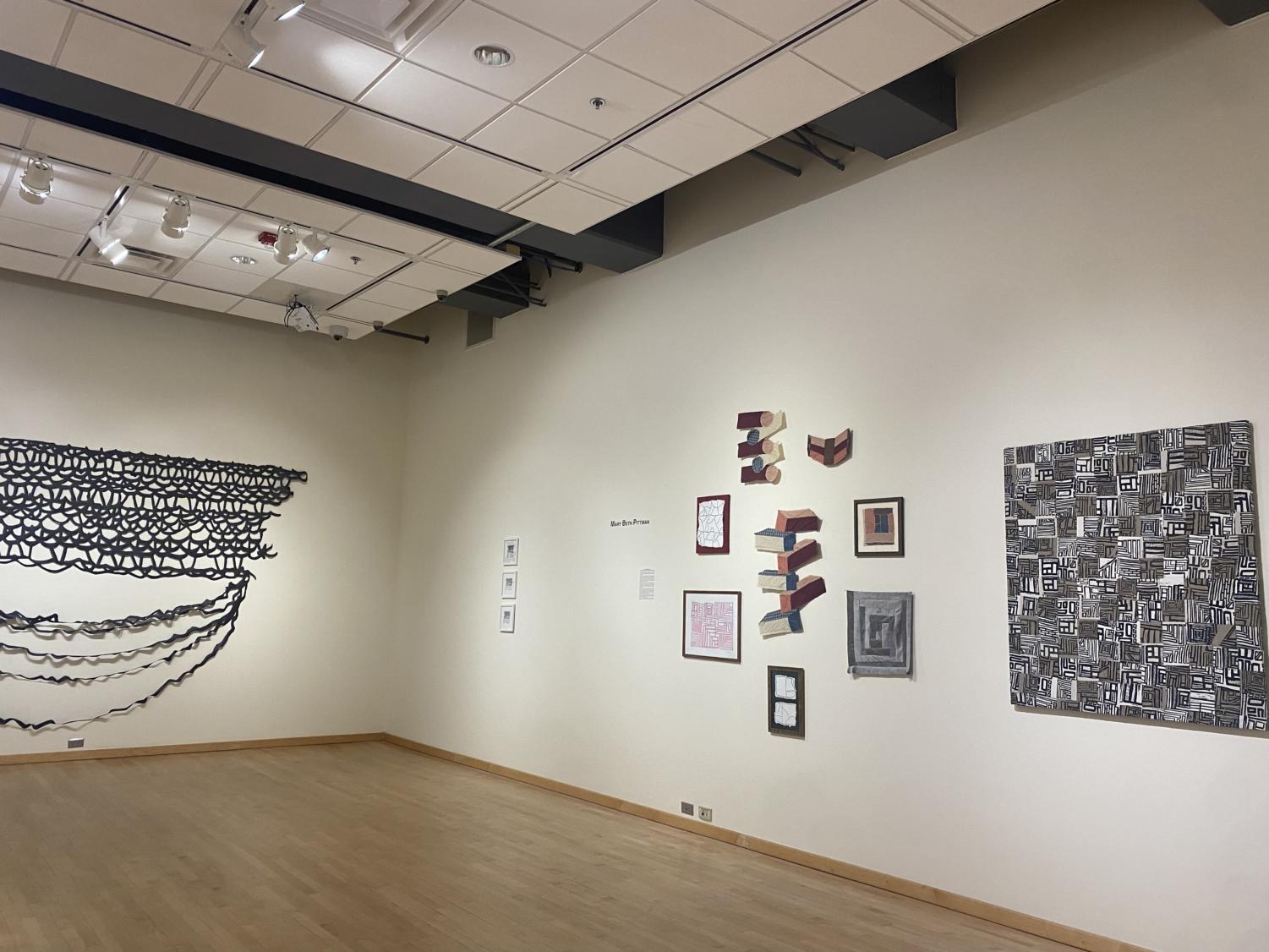
“Quilting feels like an opportunity to weave together these memories I’m trying to hold onto,” Pittman says in her artist statement.
“Though I know it doesn’t freeze time, the process in itself has become meditative, reflective. Each textile scrap holds its own story, growing more valuable when it’s intertwined with other scraps, other stories.”
Her part of the exhibit features a stretched tapestry made of hand printed Virginia cotton cloth and 208 pieces cut from their original cloth and sewn into a quilt.
“I hope to maintain the integrity of the log cabin quilting form while abstracting its recognizability,” she said. “My work here is an investigative portfolio exploring memory, domesticity, and relationships with printmaking, fiber arts, and drawing, prioritizing process over finality.”
The featured artists were not the only students who learned from the exhibition-building process. Staniar Gallery interns Maggie Hardin, ’22, Jed Heald, ’24, and Elliott Marron, ’23, helped curate the exhibit.
Heald explained some of the physical challenges of preparing the gallery for display.
“The process involves a ton of preparation with sketches and measurements as we decide where we want pieces to be placed on the wall,” Heald said. “Putting up the pieces themselves is also quite difficult because all of the pieces need to be level and spaced out evenly as noted in the sketch beforehand.”
“Setting up for the gallery was difficult because the expectation is for it to be perfect,” Harter agreed.
Dibble described the issues she faced while putting up her installation.
“I first had a mini gallery opening in the student-space Tiny Gallery with wallpaper. Unfortunately, this batch I ordered did not stick to the wall initially, and I made sure to resolve this by using different media and printing processes,” Dibble said.
“Overall, the installation went smoothly,” she assured, “mainly because I had great help: Clover Archer, Elliott Marron and Maggie Hardin.”
According to Heald, gallery interns had the chance to meet with the senior artists multiple times to help them develop ideas and plan out their exhibition’s layout.
“I was able to help both Madelyn and Mary Beth with curation, and I think both of their displays look awesome,” Heald said. “I enjoy the vivid colors of Madelyn’s and the neatly-knitted fabrics of Mary Beth’s.”
Heald studies studio art as well and enjoyed seeing peers’ work.
“The senior shows this year definitely inspired me to think creatively about my own exhibition when my time comes, and it was super cool to see all five of the students working in different mediums,” he said.
As for the artists, the process helped cement the importance of art-making in their personal lives, and seeing the exhibition come together was immensely satisfying.
“The thesis gave me a lot of time to think about how important making things with my hands is to me, and it’s something I’ll keep pursuing,” Harter said. “Knowing that I worked on something for a full year and seeing it come together is amazing.”
Sheridan also learned more about her relationship to creative work through the process.
“This process has been the most influential experience throughout my college experience,” Sheridan said. It has taught me how to be an original thinker which will help me be creative post-graduation and hopefully enhance my own ‘artistic style.’”
In addition, she learned skills that will transfer into her post-graduate career.
“This experience has also taught me about the importance of collaboration with my peers to create the best products and how to be proud of the work I present, which are both qualities I hope to bring with me to the corporate world.”
Dibble agreed.
“While I haven’t settled on plans for post-graduation yet, this experience of creating a piece from start to finish will be helpful for whatever I decide to do,” she said. “I’ve found that the communication skills, writing and speaking about my work, and meeting with visiting artists throughout the year to be so valuable and will help me in many different settings.”



